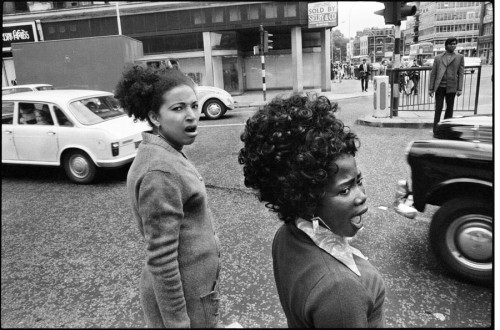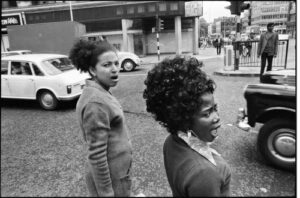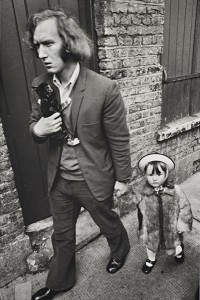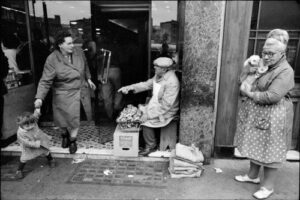
40 years ago Photo Journalist Ian Berry was commissioned to photograph the community of Whitechapel. The aim of this venture was to reach out to the community and entice them into the existing local gallery. Upon speaking to Ian I discovered that “the then curator of the Whitechapel gallery was very helpful, it had been her idea to photograph Whitechapel for the first time for the gallery, because they found they were having lots of painting exhibitions but the local people weren’t going. So the idea was to do something that would encourage local people to come into the gallery, which it did, it worked quite well.” This enabled Ian to ease himself into the community with fluidity, “she [the Whitechapel Gallery curator] knew the area and introduced me to the usual; the Toynbee Hall, the ‘meals on wheels’ and the local religious people which made my access much easier.”
Whilst Ian photographed the area he began to notice the subtle immigration pattern. The Great London Mosque, on Brick Lane, is a metaphor of these successions. In 1743 the same building was a Protestant Church catering for the French refugee community, then it became a Methodist Chapel in 1819, which lasted 71 years, before the Jewish population created ‘The Spitalfield’s Great Synagogue” which then adapted for Whitechapel’s latest majority culture and became the ‘Great London Mosque’.
Unfortunately some of the similarities between habitants of Whitechapel are that of discrimination. In the 1930’s Oswald Mosley marched his “Black Shirts” against the Jewish community, due to racial conflict. History then repeated itself again when in 1978 racial tensions between the Bangladeshi community and the National Front’s “Skin heads” reached an all time high. Bengali Children were spat on in the street and dismissed from school early to avoid trouble. Fireproof letterboxes were installed on houses and violence on the street became a normality. Consequently, on the 4th of May, Altab Ali was murdered on his way home from work.
This attack provoked the Bangladeshi community to protest and marches were held on Brick Lane between the Bangladesh Youth Movement and the National Front. Since these attacks efforts have been made to accommodate for the recent culture of Whitechapel. The park next to which Altab Ali was murdered was named after him in memory of his life and the tensions it represented. A monument was also commissioned as a saller replica of Dhaka- it symbolizes a mother and the martyred sons. Other changes for accommodation include the end of Brick Lane being renamed Bangla Town and the creation of London’s largest Mosque.
But with all that changes in Whitechapel does Whitechapel actually change? Or does time just repeat itself with a different set of beliefs?
Berry became fascinated by this continuous transition and consequently researched the catalyst for Whitechapel’s popularity. “The pattern of changing; you know originally it was the sort of people that were not allowed to live within the city walls so Whitechapel, being just outside, was home to immigrants that got off at the ships by the docks. That’s how it started and I guess today arrivals tend to go where there is already a percentage of their own ethnic group, which is why you have a lot of Bangladeshis and so on there. I suppose that to a degree will continue.” When I discussed the choice to live in Whitechapel with a verity of locals I received similar answers. “I have lived here for 50 years and I have seen many people come here to make their money and then leave.” This particular Bangladeshi man wanted to remain anonymous but his insight confirms what many others believe.
I spoke to Nigel, a worker at the renowned Bell Foundry; Britain’s oldest manufacturing company, being established in 1570. Nigel has worked at the Bell Foundry for 45 years and therefore witnessed the immigration process Ian captured. “The area was largely Jewish but during the course of the late 70s they began to move out into the suburbs and then they moved their businesses out as well. It was all very subtle though, Jewish shops and restaurants slowly disappeared and the Asians began to take them over.” I asked Nigel whether he believed the Bangladeshi community would too move away from the city center? “Yes, they do tend to have large families and you can’t have 12 people in a small flat. Once they make money with their businesses, because they work very very hard, they can buy descent seized houses in the suburbs as the Jews have done.”
As Nigel, and many other locals have noticed, there is a new cycle of immigrants moving into the area: Eastern Europeans. However I wonder whether the chain will continue, as Whitechapel has adapted significantly for the Bangladeshi community. In 1999 the East London Mosque was completed, this was the first stage of catering for the vast Muslim community inhabiting Whitechapel. The Mosque later grew to become The London Muslim Centre enabling over 15,000 Muslim’s to prayer. Further expansion is currently being pursued, insinuating that the current majority in Whitechapel is not ready to move.
Whether or not they choose to, Whitechapel is undeniably a rich location, perhaps not economically but in terms of culture and community. “It’s an interesting area I’m [Ian Berry] not a Londoner at all and it was a good insight for me. At the same time I was doing a book on the English, and Whitechapel gave me some good photographs for that.”
[All photos by Photojournalist Ian Berry, from his collection This is Whitechapel]




Leave a Reply